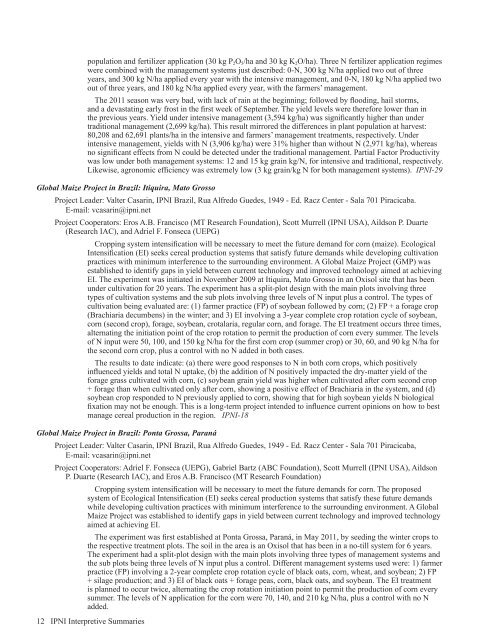Americas and Oceania Group - International Plant Nutrition Institute
Americas and Oceania Group - International Plant Nutrition Institute
Americas and Oceania Group - International Plant Nutrition Institute
Create successful ePaper yourself
Turn your PDF publications into a flip-book with our unique Google optimized e-Paper software.
population <strong>and</strong> fertilizer application (30 kg P 2 O 5 /ha <strong>and</strong> 30 kg K 2 O/ha). Three N fertilizer application regimes<br />
were combined with the management systems just described: 0-N, 300 kg N/ha applied two out of three<br />
years, <strong>and</strong> 300 kg N/ha applied every year with the intensive management, <strong>and</strong> 0-N, 180 kg N/ha applied two<br />
out of three years, <strong>and</strong> 180 kg N/ha applied every year, with the farmers’ management.<br />
The 2011 season was very bad, with lack of rain at the beginning; followed by flooding, hail storms,<br />
<strong>and</strong> a devastating early frost in the first week of September. The yield levels were therefore lower than in<br />
the previous years. Yield under intensive management (3,594 kg/ha) was significantly higher than under<br />
traditional management (2,699 kg/ha). This result mirrored the differences in plant population at harvest:<br />
80,208 <strong>and</strong> 62,691 plants/ha in the intensive <strong>and</strong> farmers’ management treatments, respectively. Under<br />
intensive management, yields with N (3,906 kg/ha) were 31% higher than without N (2,971 kg/ha), whereas<br />
no significant effects from N could be detected under the traditional management. Partial Factor Productivity<br />
was low under both management systems: 12 <strong>and</strong> 15 kg grain kg/N, for intensive <strong>and</strong> traditional, respectively.<br />
Likewise, agronomic efficiency was extremely low (3 kg grain/kg N for both management systems). IPNI-29<br />
Global Maize Project in Brazil: Itiquira, Mato Grosso<br />
Project Leader: Valter Casarin, IPNI Brazil, Rua Alfredo Guedes, 1949 - Ed. Racz Center - Sala 701 Piracicaba.<br />
E-mail: vcasarin@ipni.net<br />
Project Cooperators: Eros A.B. Francisco (MT Research Foundation), Scott Murrell (IPNI USA), Aildson P. Duarte<br />
(Research IAC), <strong>and</strong> Adriel F. Fonseca (UEPG)<br />
Cropping system intensification will be necessary to meet the future dem<strong>and</strong> for corn (maize). Ecological<br />
Intensification (EI) seeks cereal production systems that satisfy future dem<strong>and</strong>s while developing cultivation<br />
practices with minimum interference to the surrounding environment. A Global Maize Project (GMP) was<br />
established to identify gaps in yield between current technology <strong>and</strong> improved technology aimed at achieving<br />
EI. The experiment was initiated in November 2009 at Itiquira, Mato Grosso in an Oxisol site that has been<br />
under cultivation for 20 years. The experiment has a split-plot design with the main plots involving three<br />
types of cultivation systems <strong>and</strong> the sub plots involving three levels of N input plus a control. The types of<br />
cultivation being evaluated are: (1) farmer practice (FP) of soybean followed by corn; (2) FP + a forage crop<br />
(Brachiaria decumbens) in the winter; <strong>and</strong> 3) EI involving a 3-year complete crop rotation cycle of soybean,<br />
corn (second crop), forage, soybean, crotalaria, regular corn, <strong>and</strong> forage. The EI treatment occurs three times,<br />
alternating the initiation point of the crop rotation to permit the production of corn every summer. The levels<br />
of N input were 50, 100, <strong>and</strong> 150 kg N/ha for the first corn crop (summer crop) or 30, 60, <strong>and</strong> 90 kg N/ha for<br />
the second corn crop, plus a control with no N added in both cases.<br />
The results to date indicate: (a) there were good responses to N in both corn crops, which positively<br />
influenced yields <strong>and</strong> total N uptake, (b) the addition of N positively impacted the dry-matter yield of the<br />
forage grass cultivated with corn, (c) soybean grain yield was higher when cultivated after corn second crop<br />
+ forage than when cultivated only after corn, showing a positive effect of Brachiaria in the system, <strong>and</strong> (d)<br />
soybean crop responded to N previously applied to corn, showing that for high soybean yields N biological<br />
fixation may not be enough. This is a long-term project intended to influence current opinions on how to best<br />
manage cereal production in the region. IPNI-18<br />
Global Maize Project in Brazil: Ponta Grossa, Paraná<br />
Project Leader: Valter Casarin, IPNI Brazil, Rua Alfredo Guedes, 1949 - Ed. Racz Center - Sala 701 Piracicaba,<br />
E-mail: vcasarin@ipni.net<br />
Project Cooperators: Adriel F. Fonseca (UEPG), Gabriel Bartz (ABC Foundation), Scott Murrell (IPNI USA), Aildson<br />
P. Duarte (Research IAC), <strong>and</strong> Eros A.B. Francisco (MT Research Foundation)<br />
Cropping system intensification will be necessary to meet the future dem<strong>and</strong>s for corn. The proposed<br />
system of Ecological Intensification (EI) seeks cereal production systems that satisfy these future dem<strong>and</strong>s<br />
while developing cultivation practices with minimum interference to the surrounding environment. A Global<br />
Maize Project was established to identify gaps in yield between current technology <strong>and</strong> improved technology<br />
aimed at achieving EI.<br />
The experiment was first established at Ponta Grossa, Paraná, in May 2011, by seeding the winter crops to<br />
the respective treatment plots. The soil in the area is an Oxisol that has been in a no-till system for 6 years.<br />
The experiment had a split-plot design with the main plots involving three types of management systems <strong>and</strong><br />
the sub plots being three levels of N input plus a control. Different management systems used were: 1) farmer<br />
practice (FP) involving a 2-year complete crop rotation cycle of black oats, corn, wheat, <strong>and</strong> soybean; 2) FP<br />
+ silage production; <strong>and</strong> 3) EI of black oats + forage peas, corn, black oats, <strong>and</strong> soybean. The EI treatment<br />
is planned to occur twice, alternating the crop rotation initiation point to permit the production of corn every<br />
summer. The levels of N application for the corn were 70, 140, <strong>and</strong> 210 kg N/ha, plus a control with no N<br />
added.<br />
12 IPNI Interpretive Summaries

















